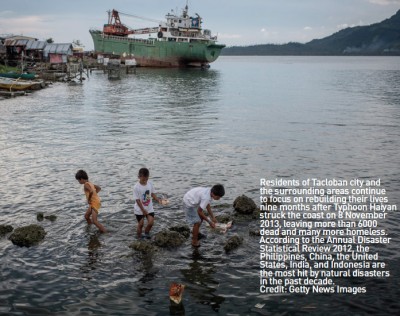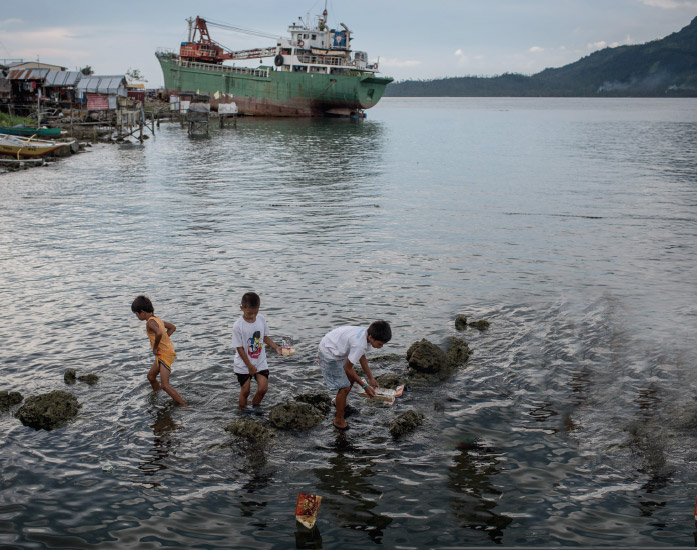
Asia accounted for 65% of global disaster victims in 2012. Hydrological disasters such as floods, storm surge, and landslides accounted for 75% of those. The Global Assessment Report on Disaster Risk Reduction 2013 (GAR13) estimated that the
total annual loss from earthquakes and cyclone wind damage alone amounts to US$ 180 billion per year.Although mortality risk has decreased, the low capacity to manage disaster risk has also led to lower levels of foreign direct investment in most countries,
including Pakistan and Nepal. Economic losses from disasters grow exponentially, and the threat to urban centres in hazard-prone countries has yet to receive saliency at the international, regional and local levels.

Asia accounted for 65% of global disaster victims in 2012. Hydrological disasters such as floods, storm surge, and landslides accounted for 75% of those. The Global Assessment Report on Disaster Risk Reduction 2013 (GAR13) estimated that the total
annual loss from earthquakes and cyclone wind damage alone amounts to US$ 180 billion per year.Although mortality risk has decreased, the low capacity to manage disaster risk has also led to lower levels of foreign direct investment in most countries,
including Pakistan and Nepal. Economic losses from disasters grow exponentially, and the threat to urban centres in hazard-prone countries has yet to receive saliency at the international, regional and local levels.

Think about Risks, Not Disasters
While some disasters are one-time events, the phenomenon of risk is continuous in nature. To ensure effective disaster risk governance, governments have consider disaster risk as an issue that requires constant attention over adopting ad hoc measures.
Recent disasters in South East Asia such as Typhoon Haiyan in the Philippines in 2013 highlighted the need for the governments to address capacities at the sub-national level, and to have a clear set of operating principles, rather than specific activities
tailored for a certain disaster. Absence of such principles as well as the lack of coordination among key stakeholders tends to compound the damaging impacts of disasters and seriously hamper community resilience. A sector-wide approach to disaster
risk management brings together donor organisations, civil society, NGOs and other stakeholders under the government umbrella.
Such a common platform develops an inclusive disaster risk management policy that can assign roles, outline an action
plan, common expenditure scheme and monitoring procedures. However, it is no easy feat. Within the existing Hyogo Framework, collaboration between state and non-state actors provides a strong foundation for governments to take on a greater role in managing
disaster risks and ensuring disaster preparedness for efficient response at all government levels. Yet the Hyogo Framework is based on voluntary commitment, and is limited in its capacity to move certain actions forward.
Within the ASEAN region, a legally binding agreement was ratified in 2009 by 10 member states: the 2010-2015 ASEAN Agreement on Disaster Management and Emergency Response (AADMER). An evaluation report in 2013 noted that many civil society organisations
are increasingly involved in advocacy work around the DRR laws in various South East Asian countries, such as in Cambodia, Lao, Indonesia, Thailand and the Philippines. This comes in stark contrast to other countries such as Myanmar. Yet there is clearly
a need to complement such types of agreements with strong research which could produce evidence on future trends and also help our understanding of the complexities underlying risk at all levels.
2015: A Successor to the Kyoto Protocol
2015 promises to be a pivotal year for the United Nations (UN). The second phase of the Hyogo Framework will be negotiated in the 3rd World Conference on Disaster Risk Reduction (DRR) in Sendai, Japan (14-18 March 2015). In Paris, France, the 21st Climate
Change Conference (COP) will anticipate a global agreement as a successor to the Kyoto Protocol. Thirdly, the post-2015 Development Agenda will be finalised with a set of Sustainable Development Goals (SDGs) building on the Millennium Development Goals
(MDGs).
There is a functional relationship between the instruments for DRR, SDGs and climate change. However, differences exists. For example, while the Hyogo Framework is a voluntary commitment with considerably shorter term goals, convention on a climate change
agreement is legally binding upon states and requires long term commitment from the governments. Recent discussions on the climate change agenda have tended to push back the debate on hazard mitigation, losing the focus on social risk and vulnerabilities.
It is essential for these processes to come together at the level of governance. Specifically, the second phase of Hyogo Framework must go beyond DRR to offer a way with the complexities underlying diverse types of risk and inter-connectedness across
countries. Experience over the past ten years has shown that having an inclusive agenda has not always been a priority, and requires building upon the existing features of risk and resilience present within the SGD framework. While the instruments of
Hyogo Framework 2 might not be fully integrated under the broad post 2015 framework, the negotiation process push the international salience of the DRR agenda further.
Despite the challenges ahead, the Third World Conference in 2015 on DRR (coordinated by the UNISDR) provides a rare opportunity to attract a broad spectrum of stakeholders, build synergies and collectively put forth a strong and clear agenda for member
states to address the growing complexity of disaster risk governance.
Caroline Brassard is Adjunct Assistant Professor at the LKY School. Email: sppbc@nus.edu.sg; Anum Anis is MPP graduate, Email: a0109586@nus.edu.sg and Lilia Saetova is MPP candidate Email: a0109586@nus.edu.sg.
On 10-11 April 2014, the LKY School hosted an expert meeting in preparation for the 2015 Global Assessment Report (GAR15) on Disaster Risk Reduction (DRR), a bi-yearly publication by the United Nations Office for Disaster Risk Reduction (UNISDR). Part
of a five-meeting series “The Future of Disaster Risk Management” is also taking place in San Jose, Costa Rica; Bangalore, India; Accra, Ghana.